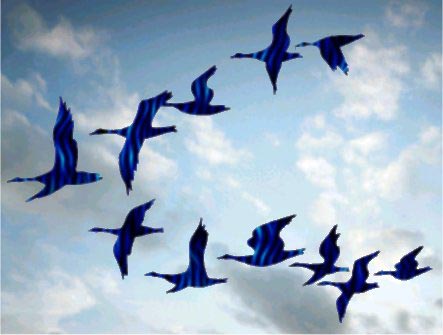Aircraft should fly like a bird
If the V-shaped planes are like birds, the amount of fuel consumed will be significantly reduced.

Neither Boeing nor Airbus have complained about the effectiveness of their latest aircraft - the 787 and A350. The Economist said that reasonable designs and lightweight composite materials make them different from all other aircraft. But an expert group of Stanford University in the US insists that airlines can adopt a very natural approach to reducing fuel consumption without having to buy new aircraft.
Dr. Ilan Kroo, a researcher at Stanford University, said the solution lies in the way birds fly. Scientists have long known that birds fly in formation. They often form a V shape, a ladder or something in the sky. When the bird flaps its wings, the air slides over the underside of the wing in the direction from the front to the back and then upwards. If you fly in a V shape, the air from your wings will help lift your body. Thus, the next fly will be less energy-efficient.
Peter Lissaman, an aviation expert from the University of Southern California in the US, said that if 25 birds fly in formation, each could save up to 71% of their energy.
Kroo and colleagues figured out what would happen if the three planes formed a V shape and took turns in the first place. They found that the amount of fuel that each aircraft consumed reduced by about 15% (resulting in a decline in CO2 emissions). The amount of nitrogen oxides that the aircraft emits during flight decreases by about 25%.
Of course, experts have many issues to consider. Safety is the first issue. If the planes fly too close together, the rear can hit the front. Kroo points out that each rear aircraft can fly a few kilometers from the front. Thus, passengers from an airplane cannot see other planes if they look through the window. Whether or not the distance between airplanes is consistent with air traffic control regulations is another matter.
Experts still do not know whether weather conditions affect air flows through airplanes. In areas with strong air disturbances, the air flow through the front plane will decay quickly and the energy-saving effect will disappear. Kroo said his team will study the issue further.
The Economist said that arranging flight time so that passenger aircraft could take off at the same time and it would not be easy to set up aerial formation. However, it became simpler for transport planes and military aircraft to follow repeated routes. The US Air Force was seriously considering the suggestion of Kroo group. In early 2009, the US Department of Defense's Senior Research Projects Department announced plans to hire Boeing to study line-up capabilities. However, the program hasn't started yet.
- Development of aircraft less sound owing to owls
- Avoiding birds attacking aircraft
- Why is the plane most afraid of hitting a bird?
- Big bird - High-speed bird of prey
- Why can heavy aircraft fly like birds?
- Airbus introduces the design of the 'Bird of Prey' aircraft.
- Positioning birds helps reduce aviation accidents
- Scientific explanation for the case of birds colliding with aircraft causing serious damage
- Chinese and Russian stealth aircraft are still much less American F-35 and F-22
- Attendance of 10 samples' extremely expensive 'iron bird' of America
- The aircraft without an engine can still reach a height of 27,000m
- Marvel at the strange bird's nest in the world
 'Fine laughs' - Scary and painful torture in ancient times
'Fine laughs' - Scary and painful torture in ancient times The sequence of numbers 142857 of the Egyptian pyramids is known as the strangest number in the world - Why?
The sequence of numbers 142857 of the Egyptian pyramids is known as the strangest number in the world - Why? History of the iron
History of the iron What is alum?
What is alum?